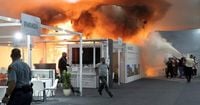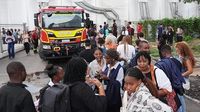As the United Nations COP30 climate summit in Belém, Brazil, barreled toward its scheduled conclusion, an unexpected crisis erupted: a fire tore through the summit venue on November 20, 2025, forcing a panicked evacuation, halting negotiations, and casting a shadow over the already fraught final days of high-stakes climate talks. With more than 190 national delegations present and critical agreements hanging in the balance, the incident could not have come at a worse time for organizers and negotiators alike.
The blaze broke out in the Blue Zone, the heart of the summit where side events and crucial negotiations were taking place, according to reports from Associated Press and France 24. The fire started near the China Pavilion and quickly spread to neighboring areas, including several Africa pavilions and the Climate Live Entertainment + Culture Pavilion. The structures, made of reinforced canvas or fabric and still showing signs of last-minute construction, proved vulnerable to the flames. Video footage captured enormous flames licking the pavilion walls as smoke filled the corridors, sending attendees scrambling for exits amid shouts of “fire!”
Authorities responded with urgency. A siren blared inside the venue, and police officers formed lines to keep people away from the affected area. Firefighters and security teams arrived within minutes, and according to Brazil’s Tourism Minister Celso Sabino, the incident was “contained” in about six minutes. “Firefighters and security teams responded promptly and continue to monitor the site,” organizers said in a statement reported by DW. Thirteen people were treated for smoke inhalation, but, remarkably, there were no serious injuries despite the chaos and confusion.
Still, the fire’s impact was immediate and far-reaching. The entire COP30 conference site was evacuated and remained closed for about seven hours as fire officials carried out safety checks and a comprehensive assessment of the damage. The Blue Zone, where the fire originated, was veiled off with curtains and guarded by security staff behind metal barricades. Some attendees returned later in the evening to retrieve belongings or resume negotiations, but the sense of disruption lingered.
For many, the fire was more than just a logistical setback. Gabi Andrade, a volunteer from the host city of Belém, described the experience as deeply distressing. “It’s so sad for us,” she told Associated Press. “We all worked so hard.” Her words echoed the frustration and anxiety that rippled through the summit, where months of preparation and anticipation had been upended in mere minutes.
The cause of the fire was still under investigation at the time of reporting. Para state Governor Helder Barbalho suggested it may have been triggered by a generator failure or a short circuit in a booth, while the local fire service pointed to an electrical device—likely a microwave—as a possible source. Two women working in a pavilion told AFP that makeshift electrical wiring, exposed wires, and water dripping onto electrical panels had raised concerns before the fire. These operational issues, combined with the venue’s unfinished state—exposed beams, open plywood floors, and ongoing construction work—created an environment ripe for trouble.
As if the fire weren’t enough, it was the third major incident at the summit, following earlier protests by Indigenous groups who stormed and blockaded the venue in peaceful demonstrations. UN climate chief Simon Stiell had previously complained to Brazil about security lapses, sweltering conditions, faulty air-conditioning, and water leaks near electrical fittings during heavy tropical rains. “The operational difficulties just before the start of this COP could have led people to believe this type of incident might occur,” one source close to the event’s organization told AFP.
The disruption couldn’t have come at a more critical moment. The summit was already running behind schedule, having missed a self-imposed deadline the day before the fire to reach agreements on key issues such as climate finance and the roadmap for phasing out fossil fuels. With the official end date looming on November 21, delegates were locked in tense debates over how to turn decades of climate pledges into concrete action. The fire forced a suspension of negotiations, with some delegations shifting to virtual meetings while the venue was closed.
UN Secretary-General António Guterres, speaking just hours before the blaze, had urged countries to “show willingness and flexibility to deliver results,” emphasizing the need for compromise and common ground. “We are down to the wire, and the world is watching Belém,” Guterres declared. “Communities on the frontlines are watching too—they have heard enough excuses. They demand results.” After the fire, his words took on added urgency. As one negotiator told France 24, “It will absolutely delay the process because this is like the crucial time, this is the time when we have to decide on the process that started last week.”
Central to the COP30 agenda were three pressing questions: how to ramp up climate action, how to unlock finance and technology for developing countries, and how to ensure that climate action is fair and inclusive. Negotiators were wrestling with proposals to boost Nationally Determined Contributions (NDCs), phase out fossil fuels, and triple adaptation finance by 2025. The Loss and Damage Fund, Green Climate Fund, and other financial mechanisms were also under scrutiny, with developing nations pushing for more support and accountability from wealthier countries. Frameworks like the Just Transition Work Programme and the Gender Action Plan aimed to guarantee that no community is left behind in the global climate transition.
Yet, as the fire underscored, the path from ambition to action is never straightforward. Some observers worried that the disruption would force rushed compromises or dilute the final agreements. “People tend to feel a little closer during an emergency like this, [...] but there are pretty deep fundamental interests at play,” said Alden Meyer of the European think-tank E3G. “You could get something that’s so weak that no one wants it.” Others, like Teresa Anderson of ActionAid, noted the pressure: “It means there is a lot to do with very little time. There were already huge gulfs to bridge and this won’t help.”
By late Thursday, the venue had reopened and negotiations were set to resume, but the sense of urgency—and vulnerability—remained palpable. The choices made in Belém, shaped in part by crisis and resilience, will determine whether the Paris Agreement’s lofty promises translate into real progress for a planet in peril. As the world watched, the delegates in Belém faced a daunting task: to rise from the ashes, quite literally, and forge a path toward a safer, more equitable future.






